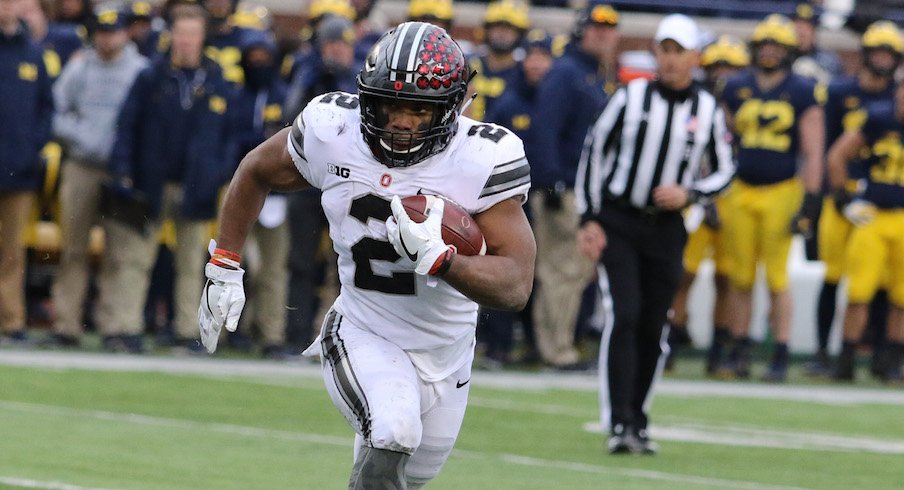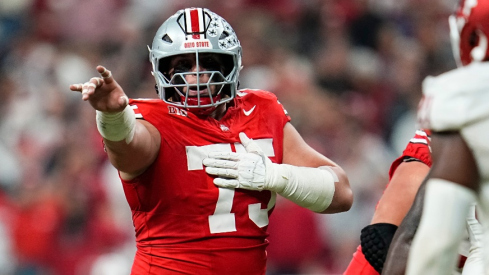ANN ARBOR, Mich. – Although Ohio State ultimately won by double digits in its 31-20 victory over Michigan on Saturday, the full box score shows that the game was closely contested in most aspects.
Ohio State outgained Michigan, but not by a huge margin (350 yards to 295). The Buckeyes had only one more first down (17 to 16). Both teams converted on about half of their third-down attempts (Ohio State: 8-of-16, Michigan: 9-of-17), both teams scored touchdowns on all of their trips to the red zone (Ohio State: 2-for-2, Michigan: 3-for-3) and the time of possession in the game was also close to even, with Ohio State possessing the ball for 31:17 compared to Michigan’s 28:43.
There are a few key statistics we can point to, though, that point to how Ohio State was able to ultimately seize control of Saturday’s game and earn its sixth straight win over its biggest rival.
Mike Weber, J.K. Dobbins run 20 times for 122 yards, 2 TDs in second half
In the first half of Saturday’s game, in which Ohio State trailed for more than 15 minutes and ultimately went into the break tied, it looked as though Saturday might be another one of those games – as our James Grega detailed after Ohio State’s most recent loss to Iowa – in which the Buckeyes would fail to get their running backs involved in their game plan and lose as a result.
J.K. Dobbins had just six carries in the first half of Saturday’s game, while Mike Weber had just one. Quarterback J.T. Barrett, by contrast, ran the ball 11 times in the first 30 minutes.
In the second half, however, Ohio State smartly adjusted and went back to committing to their tailbacks in the power running game, giving them 20 carries while their quarterbacks had just seven.
Ohio State’s hand was forced to some extent, of course, by Barrett leaving the game due to injury in the third quarter and being replaced by Dwayne Haskins, which led the Buckeyes to take the ball out of their quarterback’s hands more often. Nonetheless, though, it should serve as yet another reminder – given that Dobbins and Weber combined for 158 yards (more than 5.8 yards per carry) for the game as a whole – that the Buckeyes’ most consistently effective offense is their tailback running game, and that Ohio State should continue to rely on it to give itself the best chance to win football games, regardless of Barrett’s health going forward.
Michigan wide receivers catch only six passes
While the eye test would indicate that Ohio State’s pass defense did not have a great day on Saturday, the final box score would indicate that it did, particularly in an area it has excelled in the majority of its wins this season – shutting down opposing wide receivers.
Michigan’s wide receivers caught only six passes on Saturday, and the Wolverines’ inability to make consistent passing plays ultimately caught up with them, as they went scoreless on their final four drives of the game.
The Wolverines did get a couple big plays out of players at the position. Kekoa Crawford gained 43 yards on a screen pass that set up the Wolverines’ only second-half touchdown. Eddie McDoom briefly caused doom for Ohio State’s defense in the fourth quarter, when he gained 24 yards on an impressive downfield catch, though that drive ultimately ended in a turnover on downs.
On the other hand, Michigan’s leading wide receiver coming into the game, Grant Perry, caught just one pass for nine yards. Perhaps most importantly, Donovan Peoples-Jones – the Wolverines’ top big-play threat – finished the game without a single catch, in large part thanks to shutdown coverage by Ohio State cornerback Denzel Ward, who was Ohio State’s defensive MVP against Michigan.
Ohio State’s pass defense was helped in large part by the inaccuracy of Michigan quarterback John O’Korn, who missed targets with erratic throws throughout the game. The pass defense also had some continued and significant struggles with covering tight ends and fullbacks, though it was helped out by O’Korn inaccuracy in that regard too. At the end of the day, though, all that mattered was that Michigan – who finished the game with 195 passing yards – was unable to make enough plays in that phase of the game to end Ohio State’s winning streak.
Ohio State commits zero turnovers
On a day when Ohio State’s offense did suffer from some inconsistency, its defense suffered from some coverage busts and its punt coverage was shaky for the first time all season (allowing three returns for 54 yards to Peoples-Jones), a big reason why the Buckeyes ultimately won Saturday’s game was that they never turned the ball over.
That forced the Wolverines to work for their points, starting all but one of their drives on their own side of the field, and gave the Ohio State defense a chance to ultimately seize control of the game in the second half.
The fact that Ohio State went turnover-free can be considered especially significant because of the fact that Haskins, who lost a fumble that was returned for a touchdown one week earlier against Illinois, was a backup quarterback playing with a game on the line for the first time in his career – which is often a recipe for disaster, but was not on Saturday, as Haskins took care of the ball.
That’s not to say the Buckeyes didn’t have some close calls. Barrett threw a pass straight to Michigan safety Josh Metellus in the second quarter that should have been intercepted, but was dropped. Later in the second quarter, Barrett dropped a hot snap from Ohio State center Billy Price, bobbling it again before ultimately falling on the loose ball deep in the Buckeyes’ own territory. Either one of those plays could have been a game-changer. The fact that the Wolverines were unable to capitalize on them and get any takeaways, though, left the door open for the Buckeyes to eventually take control of the game in the second half.


